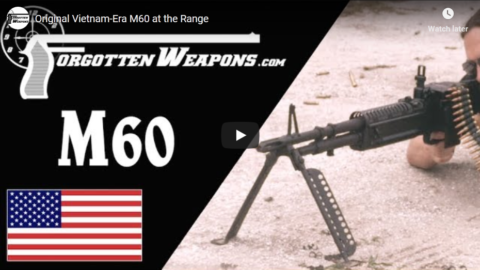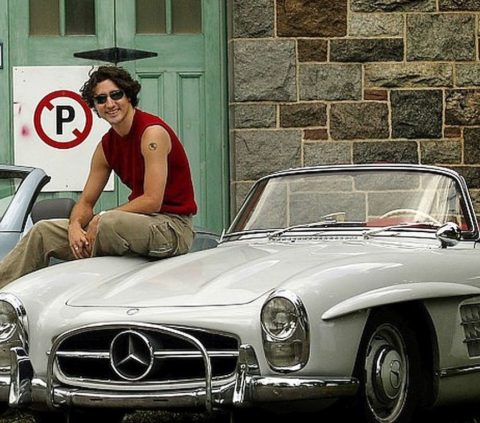Forgotten Weapons
Published on 27 Apr 2019http://www.patreon.com/ForgottenWeapons
Cool Forgotten Weapons merch! http://shop.bbtv.com/collections/forg…
The M60 was the first modern American military machine gun, developed from the operating system of the German FG-42 and the feed system of the German MG-42 in the years after World War Two. It has a rather schizophrenic reputation, being loved by many who used it in Vietnam and hated by many who used it later in its service life. The design had some fundamental flaws, but did offer a far more mobile base of fire than the M1919A6 that it replaced. Today, I am going to do a bit of shooting with an original Vietnam pattens M60, which will act as a baseline for future videos covering the various improvements and modernizations of the platform.
Thanks to the Institute of Military Technology (https://www.instmiltech.com) for giving me the opportunity to bring this M60 on camera for you!
Contact:
Forgotten Weapons
PO Box 87647
Tucson, AZ 85754
June 4, 2019
Original Vietnam-Era M60 at the Range
June 2, 2019
June 1, 2019
Viper MkI: A Simplified Steampunk Sten
Forgotten Weapons
Published on 26 Apr 2019http://www.patreon.com/ForgottenWeapons
Cool Forgotten Weapons merch! http://shop.bbtv.com/collections/forg…
The Viper Mk I was an experimental submachine gun developed in the UK for use by military policemen in post-WW2 occupation West Germany. It was a simplified Sten gun (full-auto only, without the semiauto option normally included in the Sten trigger mechanism) put into a wooden housing. It was intended to be carried slung over one shouldered [and] fired under the arm with just one hand. To this end, it had neither sights nor trigger guard. The whole concept seems pretty questionable, and while multiple different Viper submachine guns were designed to fill this role, none were ever adopted.
Many thanks to the Royal Armouries for allowing me to film and disassemble this very rare weapon! The NFC collection there – perhaps the best military small arms collection in Western Europe – is available by appointment to researchers:
https://royalarmouries.org/research/n…
You can browse the various Armouries collections online here:
https://royalarmouries.org/collection/
Contact:
Forgotten Weapons
PO Box 87647
Tucson, AZ 85754
Experimental screen capture for social media thumbnailing purposes:
May 30, 2019
Tank Chats #47 King Tiger | The Tank Museum
The Tank Museum
Published on 2 Mar 2018Known variously as the Tiger Ausf. B, Tiger II or Königstiger (the British also referred to it as the “Royal Tiger”), 489 Tiger IIs, were produced at the Henschel assembly plant, between January 1944 and March 1945. However, despite lacking in numbers, and being prone to mechanical and mobility issues based on its size and weight, the Tiger II’s combination of devastating firepower, and thick sloped armour plate made it a formidable adversary.
Support the work of The Tank Museum on Patreon: ► https://www.patreon.com/tankmuseum
Or donate http://tankmuseum.org/support-us/donateVisit The Tank Museum SHOP: ►https://tankmuseumshop.org/
Twitter: ► https://twitter.com/TankMuseum
Tiger Tank Blog: ► http://blog.tiger-tank.com/
Tank 100 First World War Centenary Blog: ► http://tank100.com/ #tankmuseum #tanks #tigertank
May 28, 2019
US Navy Driggs Mk IX 37mm Quickfire Cannon
Forgotten Weapons
Published on 23 Apr 2019This Driggs cannon and its accessories are lot #1117 at Morphy’s April 2019 auction:
https://www.forgottenweapons.com/us-n…
Developed between 1883 and 1889 by Lt. William Driggs and Commander (later Admiral) Seaton Schroeder, the Driggs cannon was an improvement on the market-standard Hotchkiss quick-fire cannon of the day. By quick-fire, I am referring to a single-shot cannon that has a recoil mechanism and ejects its empty case automatically, leaving the breech open for rapid reloading and subsequent shot. This was the standard type of naval armament for allowing large vessels to combat small and quick torpedo boats in the late 19th century. The Driggs guns were made in many variations and calibers but limited total quantities until about 1908. This example is a Mk IX type in 37mm, made in 1897.
http://www.patreon.com/ForgottenWeapons
Cool Forgotten Weapons merch! http://shop.bbtv.com/collections/forg…
Contact:
Forgotten Weapons
PO Box 87647
Tucson, AZ 85754
May 22, 2019
Hotchkiss 1914: A French and American WWI Heavy MG
Forgotten Weapons
Published on 19 Apr 2019This Hotchkiss machine gun and its tripod are lot #2027 in the upcoming April 2019 Morphy auction:
https://www.forgottenweapons.com/hotc…
The gun that became the Hotchkiss 1914 and served as the bulwark of French and American forces in World War One was actually first designed and patented by an Austrian officer; Adolph von Odkolek. He took his idea to the Hotchkiss company in Paris hoping to arrange for them to produce it under license. The design was inspected by Laurence Benet (chief engineer at Hotchkiss) and Henri Mercie (Benet’s assistant), and they concluded that the gun was not suitable for production. However, the core concept in the patent – Odkolek’s gas piston system – was a worthy one and would allow production of machine guns to compete with Maxim and Colt without violating their existing patents. So Benet arranged to simply buy the patent outright for a flat fee, and then Hotchkiss set about redesigning the gun to be much better.
The result was the model 1897, an air-cooled, strip-fed heavy machine gun that was sold to many different nations. It was improved in 1900, and between the two models sales were made to Japan, Mexico, Chile, Brazil, China, Spain, Ethiopia, Finland, Greece, Guatemala, Luxembough, Norway, Sweden, Turkey, Portugal, and Venezuela in a variety of calibers. The French government also purchased some Hotchkiss guns, primarily for colonial use. For the bulk of the metropolitan army, France opted to design its own gun in the state arsenals (which was the Modele 1907 St Etienne gun; which is suspiciously like a Hotchkiss with the operating direction of the parts reversed to avoid patent infringement).
When World War One broke out, and the need for vast quantities of machine guns became apparent, the Hotchkiss was finally adopted on a large scale by France. The commercial 1900 pattern was revised slightly (a better barrel-locking system and replacement of the shoulder stock with a D-ring rear handle) and some 45,000 would be produced by 1918. The Hotchkiss would supplant the 1907 St Etienne over the course of the war, as it was a more reliable and less expensive design. It would go on to serve the French military through the end of World War Two, gaining a reputation as a gun of unparalleled simplicity and reliability.
http://www.patreon.com/ForgottenWeapons
Cool Forgotten Weapons merch! http://shop.bbtv.com/collections/forg…
Contact:
Forgotten Weapons
PO Box 87647
Tucson, AZ 85754
May 21, 2019
Armoured Vehicles of the Invasion of France 1940, by The Chieftain – WW2 Special
World War Two
Published on 20 May 2019The Chieftain takes you on an extensive walkthrough of the armoured vehicles used by both sides during the German invasion of France in 1940.
The Chieftain’s channel: https://www.youtube.com/user/TheChief…
May 20, 2019
The Evolution Of Knightly Armour – 1066 – 1485
Metatron
Published on 16 May 2017A video full of details which took over 30 hours in the making. I hope you like it and you find the info in it useful 😀
Armour (spelled armor in the US) is a protective covering that is used to prevent damage from being inflicted to an object, individual, or vehicle by weapons or projectiles, usually during combat, or from damage caused by a potentially dangerous environment or action. The word “armour” began to appear in the Middle Ages as a derivative of Old French. It is dated from 1297 as a “mail, defensive covering worn in combat”. The word originates from the Old French armure, itself derived from the Latin armatura meaning “arms and/or equipment”, with the root armare meaning “arms or gear”.
Armour has been used throughout recorded history. It has been made from a variety of materials, beginning with rudimentary leather protection and evolving through mail and metal plate into today’s modern composites.
Significant factors in the development of armour include the economic and technological necessities of its production. For instance, plate armour first appeared in Medieval Europe when water-powered trip hammers made the formation of plates faster and cheaper.Well-known armour types in European history include the lorica hamata, lorica squamata, and lorica segmentata of the Roman legions, the mail hauberk of the early medieval age, and the full steel plate harness worn by later medieval and renaissance knights, and breast and back plates worn by heavy cavalry in several European countries until the first year of World War I (1914–15). The samurai warriors of feudal Japan utilised many types of armour for hundreds of years up to the 19th century.
Plate armour became cheaper than mail by the 15th century as it required less labour, labour that had become more expensive after the Black Death, though it did require larger furnaces to produce larger blooms. Mail continued to be used to protect those joints which could not be adequately protected by plate.
The small skull cap evolved into a bigger helmet, the bascinet. Several new forms of fully enclosed helmets were introduced in the late 14th century.By about 1400 the full plate armour had been developed in armouries of Lombardy. Heavy cavalry dominated the battlefield for centuries in part because of their armour.
Probably the most recognised style of armour in the World became the plate armour associated with the knights of the European Late Middle Ages.
May 19, 2019
Samuel Pauly Invents the Cartridge in 1812
Forgotten Weapons
Published on 4 May 2019(Video reuploaded to removed an allegedly copyrighted still image)
This Pauly shotgun (lot #1346) sold at Morphy’s April 2019 auction for $5,535.
Samuel Johannes Pauli was born outside Bern, Switzerland in 1766, and became an engineer of wide interests. Among them were bridge design, passenger-carrying balloons (he would work seriously on a 15-20 passenger balloon service between London and Paris later in life), and firearms. Only a few years after Forsyth’s invention of fulminate priming, Pauly would become the first to use it in a fully self-contained cartridge. He patented this invention in Paris in 1812, having moved there in 1802 in pursuit of financing for his many grand projects (going then by the name Jean Samuel Pauly).
Pauly’s cartridge was a multi-part affair with a rimmed brass base containing a fulminate powder, connected to a paper or cardboard cartridge body which held a charge of regular gunpowder and the shot or ball to be fired. It was an expensive system, but contained all the necessary elements of a modern cartridge.
Pauly would move to England in 1814 (then taking the name Samuel John Pauly) in pursuit of aviation inventions, although he continued to tinker on his firearms design and filed two additional patent improvements. He died in London in 1821, and his name and work became rather obscure. His former apprentices would carry on his legacy in their own work – Nicolaus Dreyse would produce the needle fire system of Dreyse rifles used by the Prussian military, and Casimir Lefaucheux would create the pinfire system based on Pauly’s designs. Lefaucheux in fact became owner of the company in 1827, and with his son would provide the most direct link between Pauly’s design and the modern metallic cartridge.
http://www.patreon.com/ForgottenWeapons
Cool Forgotten Weapons merch! http://shop.bbtv.com/collections/forg…
Contact:
Forgotten Weapons
PO Box 87647
Tucson, AZ 85754
May 16, 2019
Boys Anti-Tank Rifle: Mk I and Mk I* Improvements
Forgotten Weapons
Published on 11 Apr 2019These rifles are lots #1087 and #1088 at Morphy’s April 2019 auction:
https://www.forgottenweapons.com/boys…The Boys Anti-Tank Rifle was adopted by the British military in 1937, and remained in production until 1943 when it was replaced by the PIAT. During that time more than 114,000 were made, both in the UK and in Canada. Canadian engineers at the John Inglis company devised a number of improvements to the rifle in 1942, which were adopted as the Mk I* pattern that year. Today we are looking at these improvements with examples of each type side by side. They are a new style of muzzle brake, simplified rear sight, and improved bipod design.
http://www.patreon.com/ForgottenWeapons
Cool Forgotten Weapons merch! http://shop.bbtv.com/collections/forg…
Contact:
Forgotten Weapons
PO Box 87647
Tucson, AZ 85754
May 14, 2019
Hotchkiss Revolving Cannon from San Juan Hill
Forgotten Weapons
Published on 9 Apr 2019This Hotchkiss cannon and its accessories are lot #1116 in the upcoming April 2019 Morphy auction:
https://www.forgottenweapons.com/hotc…
Benjamin Hotchkiss was an American artillery designer who moved to Paris in 1867 in hopes of building a business for his improvements in artillery shells. He experienced the Franco-Prussian War in 1870, and understood the failure of the French Mitrailleuse multi-barrel volley guns. In his opinion, an effective rapid-fire weapon needed to fire explosive projectiles to have a real effect at extended range (unlike the Mitrailleuse which fired simple rifle bullets). So being the inventive sort, he went ahead and designed just such a gun. His revolving cannon was sized for 1-pound (450g) 37mm explosive shells (although he would also produce armor-piercing and canister ammunition). The gun looks like a Gatling gun at first glance, but its mechanical operation is quite different.
The Hotchkiss cannon would become quite popular, with major purchases by the French and American navies as well as many other nations. They would serve into World War One, including some use repurposed as antiaircraft weapons. This particular example was captured by American forces in Cuba during the Spanish-American War, most likely from San Juan Hill. It is a magnificent example of the type, and with a fantastic historical provenance to match.
http://www.patreon.com/ForgottenWeapons
Cool Forgotten Weapons merch! http://shop.bbtv.com/collections/forg…
Contact:
Forgotten Weapons
PO Box 87647
Tucson, AZ 85754
May 11, 2019
Inside the Chieftain’s Hatch. M151 Series
The_Chieftain
Published on 6 Apr 2019A fun, and rather dangerous, little softskin which will easily fit in your garage.
May 10, 2019
Microsoft can’t get worse than old Clippy? “Hold my non-alcoholic beer”
Libby Emmons reports on a new Microsoft Word plugin that puts Clippy into the history books:
Coming soon to a word processing app you probably already subscribe to is Microsoft’s new Ideas plugin. This leap forward in the predictive text trend will endeavor to help you be less offensive. Worried you might be a little bit racist? A little gender confused? Not sure about the difference between disabled persons and persons who are disabled? Never fear, Microsoft will fix your language for you.
Using machine learning and AI, Microsoft’s Ideas in Word will help writers be their least offensive, most milquetoast selves. Just like spell check and grammar check function, Ideas will make suggestions as to how to improve your text to be more inclusive. On the surface, this seems like a terrible idea, but when we dig further beneath the impulse, and the functionality of the program, it gets even worse. What’s happening is that AI and machine learning are going to be the background of pretty much every application, learning from our behaviours not only how we’d like to format our PowerPoint presentations, but learning, across platforms, how best to construct language so that we say what we are wanted to say as opposed to what we really mean.
There is an essential component of honest communication, namely that a person express themselves using their own words. When children are learning to talk and to articulate themselves, they are told to “use your words.” Microsoft will give writers the option of using someone else’s words, some amalgamation of users’ words across the platform, and the result will be that the ideas exhibited will not be the writer’s own.
May 8, 2019
Your electronic devices and the Canadian Border Services Agency
A few years ago, many civil libertarians were upset that the US government allowed warrantless searches of electronic devices at the border, but it was less well known that the Canadian Border Services Agency does the same at the Canadian border:

“Canadian Border Sign” by jimmywayne is licensed under CC BY-NC-ND 2.0
According to the CBSA, it has the right to search electronic devices at the border for evidence of customs-related offences — without a warrant — just as it does with luggage.
If travellers refuse to provide their passwords, officers can seize their devices.
The CBSA said that between November 2017 and March 2019, 19,515 travellers had their digital devices examined, which represents 0.015 per cent of all cross-border travellers during that period.
During 38 per cent of those searches, officers uncovered evidence of a customs-related offence — which can include possessing prohibited material or undeclared goods, and money laundering, said the agency.
While the laws governing CBSA searches have existed for decades, applying them to digital devices has sparked concern in an era where many travellers carry smartphones full of personal and sometimes very sensitive data.
A growing number of lawyers across Canada argue that warrantless digital device searches at the border are unconstitutional, and the practice should be stopped or at least limited.
“The policy of the CBSA of searching devices isn’t something that is justifiable in a free and democratic society,” said Wright who ran as a Green Party candidate in the 2015 federal election.
“It’s appalling, it’s shocking, and I hope that government, government agencies and the courts, and individual citizens will inform themselves and take action.”







